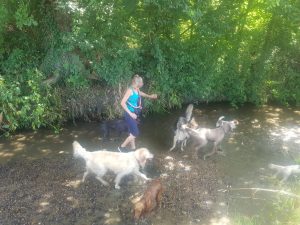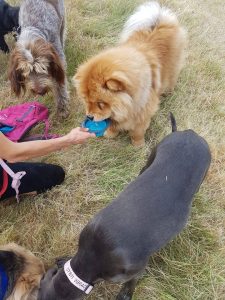During Lockdown we’ve been busy using the time to update our staff training and document all our processes, to maintain consistantly high standards throughout our setting.
We have detailed policies and procedures for successful walks, but I’ve made a simplified version for you to see the K9Adventures 5 S.T.E.P.S to Successful Walks that all staff follow to ensure every dog gets the best possible experience with us. Our daycare dogs also get to have an hour walk morning an afternoon, which sets us apart from other daycares where dogs remain on the property and do not get walked. The steps are ongoing throughout the walk and not just in the order they appear, although some are always consistent such as a safe start and a cool down. The procedures ensures constistency among our team which gives the dogs familiarity and structure which they all thrive on.
What are the 5 S.T.E.P.S ?
S – Safety
T- Train
E- Enrich
P- Play
S- Settle
I’ll be explaning each step in seperate parts so you can see how we structure our walks, and apply it to your own walks too.
S is for SAFETY
We have a routine for when each dog is picked up – first we check collars and harnesses are fitted correctly and have no damaged parts. Houses are locked up as we found them, and if anything looks amiss such as back door found open, we would contact owners immediately. We have had incidences where customers have left back doors open or unlocked and luckily, we’ve spotted it, checked for intruders and notified owners!! The dogs are taken to the van on lead and observed for anything such as limping or being off colour, which would make them unable to walk. Sometimes we have arrived to poorly dogs and diarrhoea, in these cases we notify the owner, clean up, and the dog has a toilet break instead of coming on the walk. Our vans are all fully fitted with custom made cages for safety, and air-conditioning to keep them cool.
Check harnesses for good fit.
Dogs that are a high flight risk, such as newly rehomed rescues, or dogs that have been known to escape their harnesses, always have a double-ended lead attached to both collar and harness for extra security. There are a couple of brands of harnesses we recommend that are very hard for a dog to get out of and fit well, these include ‘Ruff-Wear’ and ‘Perfect-fit’ brands.
When we arrive at our walk destination, we check the area for any hazards or other people that may be passing before we get the dogs out. and even Always on lead to start with, to walk a safe distance away from vehicles and carparks before being allowed off. Whilst on lead they are assessed for their general mood and the dynamics of the group taken into account. For example, Fido and Fred love each other but would go charging off madly playing together and not listening, so they would need a few minutes of engagement activities such as sit, wave, touch, all with positive reinforcement, before being allowed off. This ensures they are not just focused on each other but are keen to come back for their rewards (yummy treats usually, more on that another time!)
Even walking in quiet places we have to keep our eyes out for things that don’t belong there, We have come across many interesting things on my walks such as dirty nappies, adult toys (yes seriously!!), a very sharp two-pronged meat fork by a disposable BBQ, and a knife. It amazes me how the general public love to moan about dogs in public, but they are no-where near as disgusting as people!! We avoid busy local parks mainly because of the rubbish left in them is just ridiculous and dangerous.
Throughout the walk we are looking out for other natural hazards such as stagnant water or icy ponds. Weather conditions are taken into account, if necessary, we will take bottles of water and bowls with us to stop and have water breaks. If it’s hot we stick to the shade, cool woods are best for this. Water play is fun for the dogs but only in fresh flowing water such as shallow streams, not stagnant ponds or ditches. Dogs that do not cope in the heat are either taken on early morning walks before it gets hot or have home visits instead. Accessories such as cool bandanas are great for summer. We also organise regular first aid training to deal with any minor injuries that occur on walks.

Playing in fresh water not stagnant
We use long lines for dogs’ whose recall is not established. When I first started out I would use long lines everywhere, but after having to go down a step bank to the stream to untangle a long line hooked around a root, sliding down the bank to end up soaked in the stream with all the dogs laughing (yes, they do!!), We now stick to using them in open fields where risk of entanglement and us looking stupid is minimal!!
For that reason, we do not use flexileads either. When you have a group of dogs they are too bulky to hold along with the other leads, the dog on the flexilead ends up tangling or tripping up the other dogs. The thin cord type ones are the worst for giving you nasty rope burns across the backs of your legs when they hurtle behind you too fast!! They are notorious for the brakes failing on them too, I’ve heard too many stories of them snapping or the brake not working and dogs running into the road. I’ve had personal experience of a speedy beagle running down a slope after his friends on a flexilead, at such a rate I either plummeted down the slope with him or stood my ground and risked a broken neck though the whiplash effect when he got to the end of it, suffice to say I went with him and held on tight as the other option didn’t appeal to me!! That was the last time I used a flexilead!

Water Break
If you want to know more about our adventure walks and other services contact us via email sarahstevens@k9adventures.co.uk or phone 07811 386402
